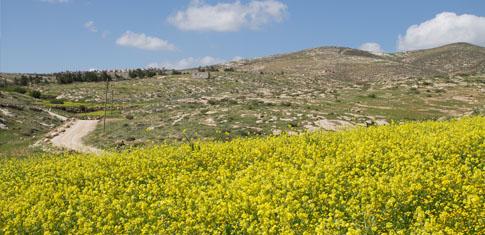When To Go
Not sure when to travel to Palestine? Here are some tips about the seasons we have.
The best times to visit Palestine – and to hike in particular – are the spring and late fall. The summer months of June through September are usually very hot, and hiking can be unpleasant or even dangerous. By mid-October, temperatures in most places have cooled down enough to make for good hiking weather that usually lasts until the intense summer heat sets in around May. The winter months (January-February) can bring rain and muddy trails; but by March flowers are in bloom, making March-April the best period for walking.

Spring
Spring is almost always the best time to hike. The winter rains usually taper off by February or March; there may still be an occasional downpour, but these are infrequent with long spells of great hiking weather in between. The spring also brings green grass and profusions of wildflowers. Palestine is at its most beautiful until about the end of April when the weather heats up and begins to turn the landscape brown again. Springtime’s moderate temperatures last longer in regions at higher elevations (e.g. parts of Nablus, Bethlehem, and Hebron regions).

Summer
Summer is not recommended for hiking trips, though there can occasionally be days when the heat is tolerable. There are also a few specific locations which are more reasonable for summer hikes (such as deep, shady canyons with running water. In particular, regions at very low elevation (e.g. Jericho) and well into the desert (e.g. some parts of the Bethlehem and Hebron regions) reach dangerously hot temperatures; we strongly recommend against hiking in these regions during the summer months.

Autumn
Autumn is a good season for hiking; it lacks the green landscapes that make spring ideal, but hikers are also less likely to encounter precipitation. Early autumn (October) may still have hot temperatures; by December the heat normally abates, but rainy weather begins to arrive.

Winter
Winter can be a good time to hike in some regions; in between spells of rain, the weather can be quite moderate. However, hiking trips can be disrupted by long rainy spells lasting days at a time. The likelihood of such conditions is generally highest in January, and rainfall gradually decreases through February and March. Some low-elevation and desert regions (e.g. Jericho and parts of Bethlehem and Hebron regions) are at their best in winter – the weather is usually warm but not hot, and there is very little rain. Regions at very high elevation (e.g. parts of Nablus, Bethlehem, and Hebron regions) can at times undergo very harsh, cold conditions in winter, including snow. Regions at moderate elevations (e.g. Jenin, Nablus) often offer good hiking weather in between periodic rainstorms.
